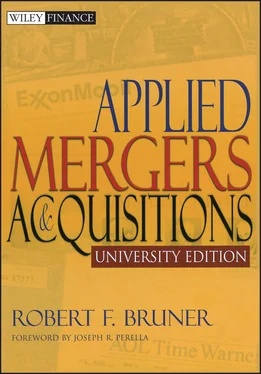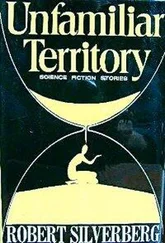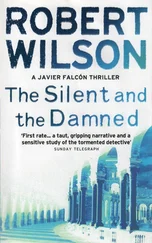MEASUREMENT OF M&A PROFITABILITY: BETTER THAN WHAT?
There is no free lunch, said Nobel laureate Milton Friedman. One of the basic conclusions of economics is that where markets are reasonably competitive, players will earn just a “fair” rate of return; you just get paid for the risk you take. The intuition for this is simple: Where information is free-flowing and entry is easy, a firm earning very high returns will draw competitors, as honey draws flies. The entry of these other firms will drive returns down to a point at which the marginal investor just gets a fair rate of return. This idea has been tested extensively in financial markets and leads to the concept of market efficiency, that prices will reflect what is known quickly and without bias. Whether a free lunch exists in M&A hinges on returns to investors, and like the tests of capital market efficiency, could be gauged in three classes of measures, sketched in Exhibit 3.1:
1 Weak form. Did the share price rise? Are the shareholders better off after the deal than they were before? For instance, this would compare whether the buyer’s stock price was higher after the deal than before. This before-and-after comparison is widespread, especially in the writings of journalists and consultants. But it is a weak test because it fails to control for other factors that might have triggered a price change, unrelated to the deal. Stock prices are driven by random noise, marketwide effects, and other firm-specific events, of which firms generate a lot. As an exercise, pick a merger announcement, and then do a scan of all the news stories that pertain to the firm for several months or years afterward. The odds are that the merger will be a minute portion of the news that drove your firm’s share prices. For this reason, weak form tests are notoriously unreliable. EXHIBIT 3.1 Classes of Tests of M&A ProfitabilityTestStructure: M&A Pays If:Description and CommentsWeak formPAfter > PBeforeDoes the firm’s share price improve from before to after the deal? A comparison widely used by consultants and journalists. Unreliable. Vulnerable to confounding events at the firm and marketwide effects.Semistrong form%RM&A Firm > %RBenchmarkDoes the return on the firm’s shares exceed that of a benchmark? Widely used by academic researchers. Depends for its integrity on good benchmark selection and large samples of observations.Strong form%RFirm with M&A > %RFirm without M&ADoes the return on the firm’s shares exceed what it would have been without the deal? The “gold standard” test, but unobservable.
2 Semistrong form. Did the firm’s returns exceed a benchmark? Are shareholders better off compared to the return on a benchmark investment? Introducing a benchmark like the return on the S&P 500 index, or the return on a matched sample of peers that did not merge, strengthens the analysis. This kind of test, widespread in academic research, dominates the weak form tests because it controls for the possibility that the observed returns were actually driven by factors in the industry or entire economy, rather than due to the merger. But this kind of test is at best semistrong because benchmarks are imperfect. For instance, which firm would have been a good benchmark comparison to Walt Disney at the time of its acquisition of ABC Cap Cities? We could name some entertainment and real estate firms, but at the end of the comparison, we should still harbor some unease about noise and confounding effects. Taking care to choose good benchmarks and using large samples, researchers hope to minimize the weaknesses of semistrong form tests.
3 Strong form. Are shareholders better off after the deal than they would have been if the deal had not occurred? This question poses the true test of the cost of lost opportunity, the economists’ “gold standard” of comparison. And it is what most people think they are finding when they look at weak and semistrong form test results. But the true strong form test will tell a sharper story. Consider the case of AOL’s acquisition of Time-Warner in January 2000. The weak and semistrong tests will reveal sizable losses to AOL’s shareholders over the years following the deal. But given the implosion of the Internet industry after 2000, it seems likely that AOL’s shareholders would have been much worse off without the merger. It would appear that AOL’s acquisition of Time-Warner was shrewd and successful for the buyer, 3 despite what the weak and semistrong results show. The problem is that strong form results are unobservable.
The distinction among these three kinds of tests is important to bear in mind. The studies summarized in this chapter are, at best, semistrong. Therefore, we must exercise humility in drawing conclusions about performance against economic opportunity. We are looking through a glass darkly.
Four research approaches offer findings relevant to forming a view about M&A profitability:
1 Event studies. These examine the abnormal returns to shareholders in the period surrounding the announcement of a transaction. The raw return for one day is the change in share price and any dividends paid, divided by the closing share price the day before. The abnormal return is simply the raw return less a benchmark of what investors required that day—typically, the benchmark is the return dictated by the capital asset pricing model (CAPM) or quite simply the return on a large market index, such as the S&P 500. These studies are regarded to be forward-looking on the assumption that share prices equal the present value of expected future cash flows to shareholders. Since the 1970s, these studies have dominated the field. 4
2 Accounting studies. These examine the reported financial results (i.e., accounting statements) of acquirers before, and after, acquisitions to see how financial performance changed. The focus of these studies ranges across net income, return on equity or assets, earning per share (EPS), leverage, and liquidity of the firm. The best studies are structured as matched-sample comparisons, benchmarking acquirers against nonacquirers based on industry and size of firm. In these studies, the question is whether the acquirers outperformed their nonacquirer peers.
3 Surveys of executives. Simply asking managers whether an acquisition created value seems like an obvious course. These present a sample of executives with a standardized questionnaire, and aggregate across the results to yield generalizations from the sample.
4 Clinical studies. These focus on one transaction or on a small sample in great depth, usually deriving insights from field interviews with executives and knowledgeable observers. This is inductive research. By drilling down into the detail and factual background of a deal, the researchers often induce new insights.
Exhibit 3.2summarizes the approach, strengths, and weaknesses of each research method. Plainly, no research approach is fault-free, though some command more respect of scientific researchers than do others. The task must be to look for patterns of confirmation across approaches and studies, much as one sees an image in a mosaic of stones.
If “scientific inquiry” means anything, it is to frame a hypothesis and test it rigorously against the possibility that the result is merely due to chance. Strictly speaking, one never proves the hypothesis, one only disproves the “null hypothesis” that the phenomenon is due to chance. The event studies and accounting studies are excellent examples of the scientific method applied to social phenomena. Surveys and clinical studies are usually not tests of hypotheses; they aim to describe, rather than test. The key test by which an event study or accounting study proves its finding is with the “t-statistic.” The derivation and history of this statistic are beyond the scope of this discussion. But the novice in this field must note that the t-statistic indicates the probability that the result was due to chance—the higher the t value, the lower the probability of a chance occurrence. 5 By informal convention, many financial economists look for t-values in excess of 2.0, generally indicating significance at the 95 percent level of confidence that the result could not be due to chance. There is, however, nothing magical about the 95 percent level of significance; a confidence level of 90 percent (t = 1.67) is still relatively rare. Statistical studies never prove a phenomenon with certainty; at best, we can say that a result is probably not due to chance.
Читать дальше












